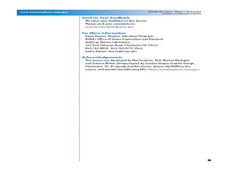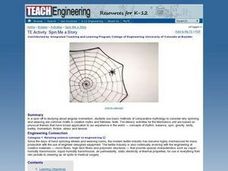Curated OER
Destination Outer Space
Students investigate space travel. In this space travel lesson students examine space exploration history, engineers and scientists involved in space exploration, and Newton's third law of motion. Students make rockets.
Institute of Electrical and Electronics Engineers
Get Connected with Ohm's Law
Ideal for your electricity unit, especially with middle schoolers, this lesson plan gets engineers using multimeters in electrical circuits to explore the relationships among voltage, current, and resistance. Older learners may even plot...
TryEngineering
All About Electric Motors
Learners study the basic principles of electric motors and explore everyday uses. They build a working model of an electric motor for classroom use, using an inexpensive kit. Then, they work as an "engineering" team to determine the...
Curated OER
Electrical Generators
Learners study what an electric generator does and its history. In this energy lesson students complete several experiments including building their own electric generator.
Curated OER
Go with the Flow
Students gain an understanding of the difference between electrical conductors and insulators, and experience recognizing a conductor by its material properties. They build a conductivity tester to determine whether different objects are...
Curated OER
Take Charge!
Learners induce an electrical charge on various objects, and experiment with electrical repulsion and attraction. They define related vocabulary, play Bingo and complete a take-home quiz.
Curated OER
Where's the Energy
Students research energy conversions. For this energy lesson, students describe the basic operation of a steam engine. They explain the energy conversions in the steam engine's operation.
University of Minnesota
Virtual Neurons
It's electric! Young anatomists use Virtual Neurons software to build, control, and analyze complex nerve circuits within the body. Colorful and packed with content, class members enjoy interacting with the nervous system at a personal...
Institute of Electrical and Electronics Engineers
Clipper Creations
Learners create their own model of a nail clipper. They practice using engineering design and model building. They also identify different kinds of small levers.
Curated OER
What is the Best Insulator: Air, Styrofoam, Foil, or Cotton?
Students investigate the properties of insulators by attempting to keep a cup of water from freezing, and once it is frozen, to keep it from melting. They conduct the experiment, record and analyze the results, and answer discussion...
Curated OER
Spin Me a Story
Students examine the motif of spinning and weaving in myths and folktales. They read various myths, complete a WebQuest, develop a mind map of story elements, and write an original "spider" story.
Curated OER
Steamship Portland: Where's the Energy?
Students examine how steamships operate. They describe the necessary energy conversions. They construct a model paddlewheel ship. They use rubber bands as examples of potential and kinetic energy as they unwind and set the models in motion.
Curated OER
Waste Aggregates and Material Properties
Students define specific waste materials that could be used as aggregate in concrete. In this aggregate and waste lesson plan, students brainstorm on how to incorporate waste in construction and define different aggregate materials.
Curated OER
Buoyant Boats
Students design and construct a boat out of aluminum foil and a few other simple materials. The boats then be tested by floating them in water, then adding mass until they sink. They explore the various shapes of boat construction.















